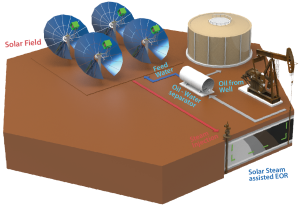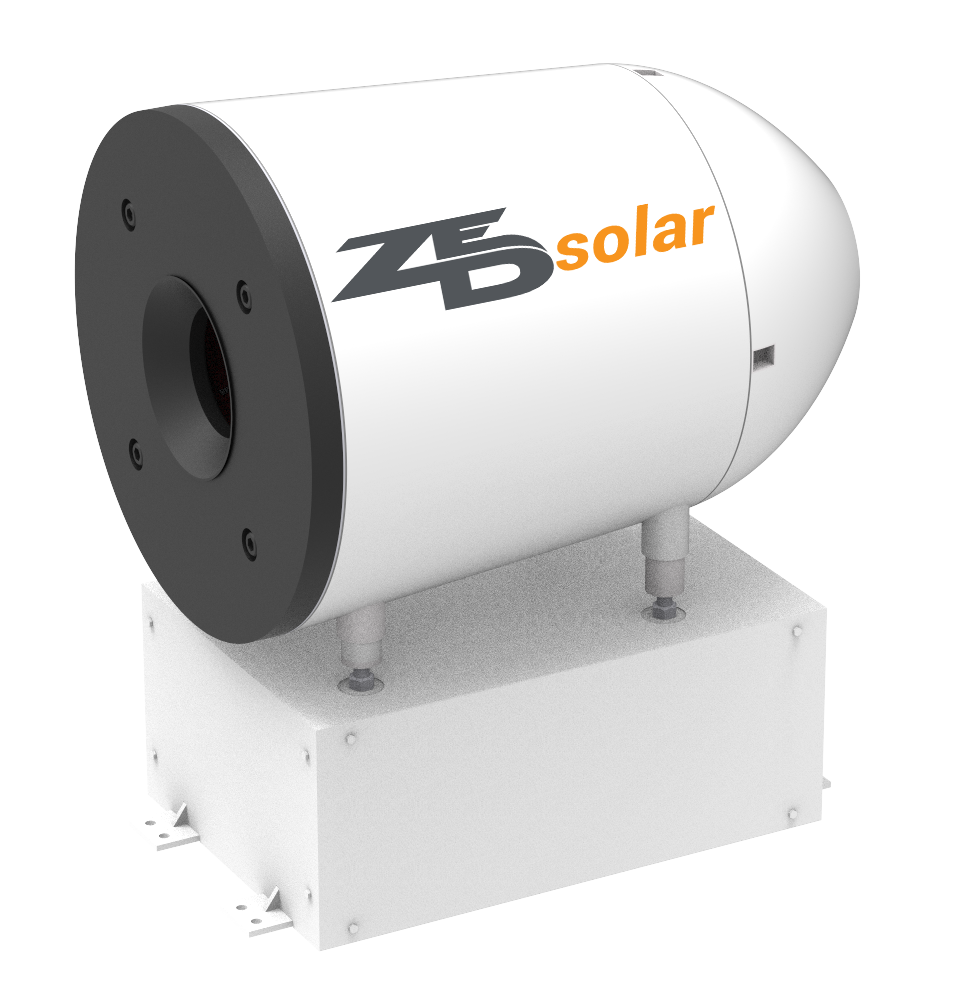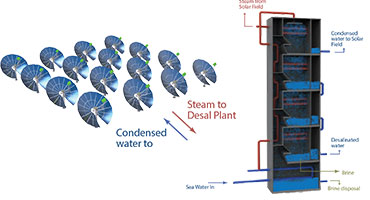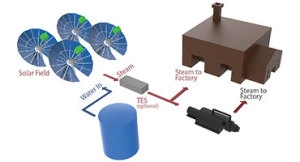The Solar Invictus parabolic sun dishes form the heart of our system to generate solar steam for Enhanced Oil Recovery (EOR). We recognized that oil fields are unique environments and need solutions that are designed to face these particular challenges. Our systems use the same feed water as existing oil industry standard Once Through Steam Generators (OTSG) use and produce exactly the same steam quality. Ultra high efficiency combined with low capital costs help to deliver a Levelised Cost of Energy (LCOE) that is approximately 30% below that of our nearest solar competitor and also cheaper than natural gas by the same margin. Our systems also offer a reduction in natural gas consumption by 80% as well as in CO2 emissions.
The Solar Invictus can be used in an ISSC role offering an effective hybrid solution for injecting cheap and clean solar steam into the more traditional power generation cycle.
Unlike solar trough systems, the sun dish generates solar steam at 565°C thereby avoiding the need to use a carbon-based fuel to boost the steam temperature before injecting into a steam turbine.
An ISSC combines the benefit of clean energy with the on-demand dispatchability of a traditional gas plant.
Desalination is taking on greater significance as fresh water becomes scarce. Although it is an absolutely essential process, desalination is also very energy-intensive. In the Middle East the combination of a lack of fresh water and high level of solar irradiance make it an ideal region for using Solar Invictus sun dish systems combined with a thermal desalination process such as Multi Effect Distillation (MED)
The Solar Invictus makes it possible to not only run a desalination plant without producing any emissions but also to achieve a lower cost of producing input steam than by burning natural gas.
34-A Zafar Ali Road
Gulberg 5
Lahore 54660
Pakistan
T: +92 42 35870263
F: +92 42 35870069
© copyright 2014-2015 ZED Solar. All Rights Reserved.
Job Purpose:
To lead a team of control systems engineers to design and develop embedded control systems for automation of electro-mechanical equipment and processes
Qualification:
BS (preferably Masters) Electrical/Electronics/Mechatronics/Controls System Engineering.
Experience:
Min 8 years’ experience in design and development of embedded control systems (preferably for controlling/automating mechanical equipment and processes). Minimum three years in lead role
Skills & Abilities
Duties and Responsibilities:
Job Purpose:
To undertake work related to detailed thermal design and simulations of solar thermal systems
Qualification:
BS Mechanical Engineering (Experience in Thermal Design, Direct Steam Generation)
MS Thermal Engineering .
Experience: 2-3 years in thermal designing of commercial systems or as research associate in thermal engineering field.
Skills & Abilities
Duties and Responsibilities:
Job Purpose:
For embedded system development assistance, making of PCBs, testing and improvements.
Qualification: Bachelor’s degree in Electrical/Electronics/Mechatronics and Control Engineering or similar field.
Experience: 0 to 2 years in relative field
Skills & Abilities
Duties and Responsibilities:
ZED Solar is looking for a qualified and experienced Chief Operating Officer or COO oversees the organization’s ongoing operations and procedures. He is responsible for inspecting the efficiency of business.
The COO is a key member of senior management and is accountable for supervising the entire organization reporting only to the Chief Executive Officer (CEO).
Qualification: Master’s in Business Administration with a background in engineering.
Experience: 10+ years of progressively responsible experience for a major company or division of a large corporation. The experience must be in company with global manufacturing locations and operations, preferably in the engineering sector. Should have experience in partnering with an executive team, and have a high level of written and oral communication skills.
Skills & Abilities:
Role & Responsibilities:
Equal Employment Opportunity Statement
ZED Solar is an Equal Opportunity Employer encouraging diversity in the workplace. Candidates are judged on merit, qualifications, competence and suitability and are not discriminated on the basis of gender, race, age, religion, or disability.
(Females are encouraged to apply)
ZED Solar is looking for a qualified and experienced Chief Financial Officer, accountable for the administrative, financial, and risk management operations of the company, to include the development of a financial and operational strategy, and metrics tied to that strategy. Develops financial well-being of the organization by providing financial projections and accounting services; preparing growth plans; directing staff.
Qualification: CA/CIMA/ACMA
Preference will be given to candidates with a master’s degree in accounting or business administration and the Certified Public Accountant or Certified Management Accountant designations.
Experience: 10+ years of progressively responsible experience for a major company or division of a large corporation, experience in technology and manufacturing companies would be preferred. Experience in raising funds through equity and debt would be preferred along with a track record of preparing and going through an IPO. Should have experience in partnering with an executive team and have a high level of written and oral communication skills.
Skills & Abilities:
Role & Responsibilities:
Equal Employment Opportunity Statement
ZED Solar is an Equal Opportunity Employer encouraging diversity in the workplace. Candidates are judged on merit, qualifications, competence and suitability and are not discriminated on the basis of gender, race, age, religion, or disability.
(Females are encouraged to apply)
ZED Solar Ltd is urgently looking for “Freelance Field Engineer” in Kuwait.
Job Duration: 3 Months
Job Location: Kuwait (Work site is located in the Abdali area on Route 80 (1 hour driving distance from Kuwait City)
Visa status: Candidate must have a valid Residence visa with work permit
Qualification: Electrical / Electronics / Mechatronics engineer required
Experience: Candidate should have hands-on experience with PLCs, Embedded systems, field instrumentation and rotary equipment (Operational experience in remote environment for complex equipment is preferred)
Skills & Abilities
Work Conditions & Duties:
Role & Responsibilities:
Send CV, covering letter and recent photograph via email latest by 4th April 2016: cv@zedsolar.com
Note: Please indicate the position you are applying for in the subject line of the email and do specify the advertisement reference as well.
Important: Eligibility Criteria: Either already resident or eligible for Kuwait Visa (for example Sri Lankan/Bangladeshi)
Job Purpose:
Primarily to operate and maintain Kuwait Demo Dish
To install and commission solar park
To operate and maintain solar park
Qualification: B-Tech or BS Mechanical Engineering
Experience: Minimum 3 years of experience in mechanical operation and maintenance (preferable is background in solar thermal park maintenance).
Skills & Abilities
Duties and Responsibilities:
Work Relationship: Engineer will report to Management.
Important: Eligibility Criteria: Either already resident or eligible for Kuwait Visa (for example Sri Lankan/Bangladeshi)
Job Purpose:
Primarily to operate and maintain Kuwait Demo Dish
To install and commission solar park
To operate and maintain solar park
Qualification: Bachelor’s or equivalent Degree in Electronics/Control Systems Engineering
Experience: 3+ years experience in control systems and plant operations (preferably Solar Thermal Park)
Skills & Abilities
Duties and Responsibilities:
Work Relationship: Engineer will report to Management.
Job Purpose:
ZED Solar is looking for a qualified and experienced SCADA ENGINEER responsible for designing, developing, integrating, and maintaining SCADA systems for Solar Power Plant.
Qualification: Bachelor’s degree in Computer Science/Electrical/Control Engineering or similar field required with 3-5 years’ experience. 3 years SCADA experience in the oil and gas pipeline industry is preferred.
Experience: 3 to 5 years in relative field
Skills & Abilities
Duties and Responsibilities:
Job Purpose:
Operation of Demo Solar Park on site.
Qualification: Bachelor’s degree in Electrical/Electronics/Mechatronics and Control Engineering or similar field.
Experience: 0 to 2 years in relative field
Duties and Responsibilities:
Job Purpose:
For steam piping instrumentation and control design, selection and development.
Qualification: Bachelor’s degree in Electrical/Electronics/Mechatronics and Control Engineering or similar field.
Experience: Minimum 5 years in Design Project management role
Skills & Abilities
Duties and Responsibilities:
Job Purpose:
To assess and design accordingly the electrical systems for Solar Park, costing, sourcing etc included
Qualification: Bachelor’s degree in Electrical/Electronics/Mechatronics and Control Engineering or similar field.
Experience: Minimum 2 years in relative field
Duties and Responsibilities:
Job Purpose:
For embedded system development assistance, making of PCBs, testing and improvements.
Qualification: Bachelor’s degree in Electrical/Electronics/Mechatronics and Control Engineering or similar field.
Experience: 0 to 2 years in relative field
Skills & Abilities
Duties and Responsibilities:
Job Purpose:
To make HSE plans for manufacturing facility.
To make HSE plans to fulfill contractual, legal and statutory requirements for solar park construction and operation.
To ensure that HSE risks are identified, assessed and managed for all project activities in order to ensure that a safe and high quality project execution and delivery is achieved at the Project sites.
To provide timely and accurate HSE advice and assistance to other departments if required.
Qualification: S Mechanical/Chemical
Certification with NEBOSH/IOSH will be considered an added advantage
Experience: Experience in implementing OHSAS 18001, conducting trainings/ awareness sessions/ workshops, Inspections and incident investigations in a corporate organization.
Skills & Abilities
Duties and Responsibilities:
Work Relationship
Will report to Director Technical.
Coordinate with manufacturing facility administrator and engineers, Installation teams, site engineers and contractors for HSE plans implementation.
Direct coordination with employees and workers for HSE awareness sessions.
Job Purpose:
To provide technical expertise in optimization of piping, valve and equipment life. To develop water composition analysis and treatment procedures (for field application).
Qualification: Graduate in Chemical engineering
Experience: 2 to 3 experience in boiler’s de-scaling and maintenance and water treatment operations in the process industry
Experience in maintenance activities for corrosion control in pipelines
Skills & Abilities
Duties and Responsibilities:
Work Relationship
Will report directly to the technical director or project manager
Job Purpose:
To manage supply chain and to efficiently execute purchasing and logistics tasks within budget.
Qualification: Bachelor’s degree in mechanical or industrial engineer.
Experience: 1 to 3 years of experience in the Supply Chain Management of a reputed company
Skills & Abilities
Duties and Responsibilities:
Work Relationship
The Supply Chain engineer will directly report to Management.
The Supply Chain engineer will be actively interacting with design, manufacturing, quality assurance, store purchasing and accounts functions within the company.
The Supply Chain engineer will be actively interacting with external suppliers, vendors, service providers, freight forwards and customs.
Job Purpose:
To design foundations, site layouts, fencing and other structural elements in Solar Park.
Qualification: Graduation in Civil Engineering from a reputed educational institution
Experience: 2 to 3 years of design experience is required
Candidates with field experience will be preferred
Skills & Abilities
Duties and Responsibilities:
Work Relationship
The Structural Engineer will report to Director Technical
Job Purpose:
To plan, budget and execute Solar Park construction.
Qualification: Graduation in Civil Engineering from a reputed educational institution
Experience: 2 to 4 years of project planning and execution is required
Candidates with structural design experience will be preferred
Skills & Abilities
Duties and Responsibilities:
Work Relationship
The Planning and Execution Engineer will report to Director Technical.
Job Purpose:
To design new mechanical/electromechanical systems/sub-systems.
To improve existing systems/sub-systems.
To design variants of existing systems/sub-systems.
Qualification: Graduate in Mechanical Engineering.
Experience: Fresh or 2/3 years of Mechanical Design experience.
Skills & Abilities
Duties and Responsibilities:
Work Relationship
The Mechanical Design Engineer will report to Sr. Engineer (R&D)/Mechanical.
The Mechanical Design Engineer will get support of other design engineers and draftsmen in the design activities.
The Mechanical Design Engineer will be coordinating with other disciplines, vendors/suppliers for the accomplishment of the objectives.
Job Purpose:
To oversee, streamline, organize and assist in product development and production activities at the manufacturing site. To provide a link between design and manufacturing activities together with scheduling and budgeting.
Qualification: Graduate in Mechanical or Industrial Engineering.
Experience: 2 to 4 years of Industrial/Manufacturing experience.
Skills & Abilities
Duties and Responsibilities:
Work Relationship
The Manufacturing Engineer will report to the Production & Development Manager / Assistant Manager.
The manufacturing supervisors and other resources will directly report to the Manufacturing Engineer.
Job Purpose:
ZED Solar is looking for a qualified and experienced Sr. Engineer (CAE), To carryout and lead computer assisted engineering analysis involving FEA & CFD for new product designs and modifications for improvements in existing products.
Qualification: Graduate in Mechanical Engineering.
Masters in CAE is preferable.
Experience: 3-5 years of experience as FEA/CFD/CAE engineer.
Skills & Abilities
Duties and Responsibilities:
Work Relationship
The Sr. Engineer (CAE) reports to Director Technical.
The Sr. Engineer (CAE) gets support from other engineers and draftsmen in the design activities
Job Purpose:
ZED Solar is looking for a qualified and experienced Thermal Design Engineer , To undertake work related to detailed thermal design and simulations of solar thermal systems
Qualification: BS Mechanical Engineering (Experience in Thermal Design, Direct Steam Generation)
MS Thermal Engineering
Experience: 2-3 years in thermal designing of commercial systems or as research associate in thermal engineering field.
Skills & Abilities
Duties and Responsibilities:
Work Relationship
Thermal Design Engineer will report to Director Technical.




